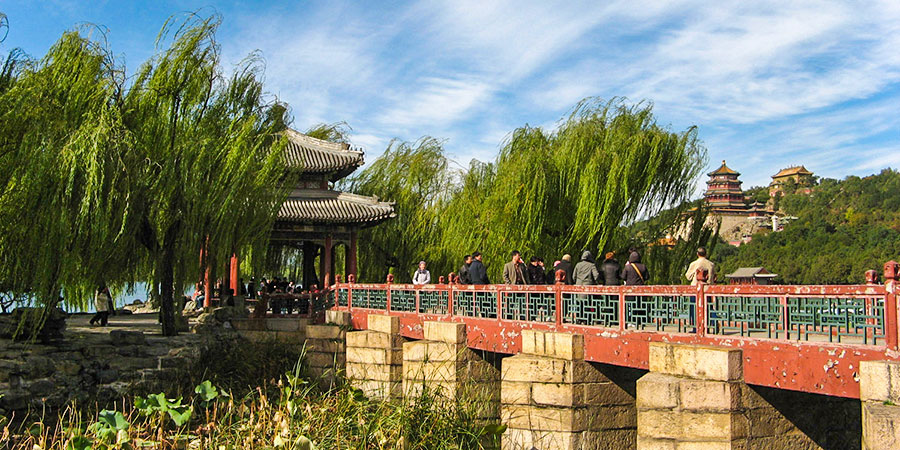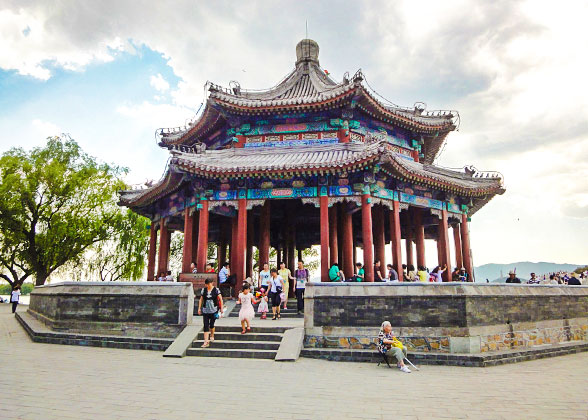East Causeway (Dongdi)
The East Causeway stretches from Wenchang Tower (or Tower of Literary Prosperity) in the north to the Xiuyi Bridge in the south. It has an unobstructed view of the whole area, which includes the West Hill, the Jade Spring Mountain and the pagoda on the hill top. One really has to marvel at the exquisite design effort that went into the causeway itself.
The double decked Wenchang Tower straddles on a 10-meter-high square pass. It is the largest pass tower of the six in the Summer Palace. It was modified during Emperor Dowager Cixi’s Summer Palace reconstruction. A bronze statue of Wenchang Dijun (God of Cultural and Literature) is placed in the tower. To the north of Wenchang Tower, a narrow pavement with a pavilion on it connects a tiny island to the causeway. The Pavilion of Heralding Spring salutes each spring with the help of its willow trees. This place is, so to speak, a nice location to have a short break with a panoramic view.The Newly-Built Palace Gate faces the East Causeway from the south. It was once newly built in the reign of Emperor Guangxu to secure the place formerly guarded by sentinels. Outside the gate is an archway with four pillars which was built in 1985 to replace an old structure.
The Bronze Ox and Kuoru Pavilion on the east end of the Seventeen-Arch Bridge embrace the Nanhu Island in a scheme of harmony. Kuoru Pavilion, most prominent of the forty pavilions in the Summer Palace, is also the nation’s largest. It has two layers of eaves, octagonal roof, forty-two pillars and open corridor around the pavilion.
Not far from the Bronze Ox, there is the Kunlun monument with a poetic inscription by Emperor Qianlong relating how the place name got changed. The causeway was originally built along the ‘West Lake’ (former name of Kunming Lake) as dike protection for the Changchun Garden in the east. It was hence known as the 'West Causeway' to protect the garden from flood danger. Emperor Qianlong extended the lake area further eastwards and so did the causeway, which eventually became the East Causeway.
A monument north of the Xiuyi Bride, at the south end of the East Causeway exhibits engravings from six poems composed by Emperor Qianlong in the 29th year under his reign. Xiuyi Bridge was built five year earlier than the time when the poems came into being. It defines the boundary of the Kunming Lake and Changhe River (the water channel to Zizhuyuan Garden), the West Causeway and the East Causeway. The South Ruyi Gate is right to the south of the bridge.
The ingenious design of the Ease Causeway makes every visitor convinced the creative wisdom of the builders. Aside from the remarkable ornamental structures, it borrows the scenery of the West Hill afar as a poetic background, giving rise to an extended vision from the lake surface to the trees along the banks, then to the yonder mountain.
The double decked Wenchang Tower straddles on a 10-meter-high square pass. It is the largest pass tower of the six in the Summer Palace. It was modified during Emperor Dowager Cixi’s Summer Palace reconstruction. A bronze statue of Wenchang Dijun (God of Cultural and Literature) is placed in the tower. To the north of Wenchang Tower, a narrow pavement with a pavilion on it connects a tiny island to the causeway. The Pavilion of Heralding Spring salutes each spring with the help of its willow trees. This place is, so to speak, a nice location to have a short break with a panoramic view.The Newly-Built Palace Gate faces the East Causeway from the south. It was once newly built in the reign of Emperor Guangxu to secure the place formerly guarded by sentinels. Outside the gate is an archway with four pillars which was built in 1985 to replace an old structure.
 |
| The Bridge on the East Causeway |
The Bronze Ox and Kuoru Pavilion on the east end of the Seventeen-Arch Bridge embrace the Nanhu Island in a scheme of harmony. Kuoru Pavilion, most prominent of the forty pavilions in the Summer Palace, is also the nation’s largest. It has two layers of eaves, octagonal roof, forty-two pillars and open corridor around the pavilion.
Not far from the Bronze Ox, there is the Kunlun monument with a poetic inscription by Emperor Qianlong relating how the place name got changed. The causeway was originally built along the ‘West Lake’ (former name of Kunming Lake) as dike protection for the Changchun Garden in the east. It was hence known as the 'West Causeway' to protect the garden from flood danger. Emperor Qianlong extended the lake area further eastwards and so did the causeway, which eventually became the East Causeway.
 |
| Gallery Pavilion |
The ingenious design of the Ease Causeway makes every visitor convinced the creative wisdom of the builders. Aside from the remarkable ornamental structures, it borrows the scenery of the West Hill afar as a poetic background, giving rise to an extended vision from the lake surface to the trees along the banks, then to the yonder mountain.
![]() Next: Seventeen-Arch Bridge
Next: Seventeen-Arch Bridge
![]() Related Link: Summer Palace Travel Tips
Related Link: Summer Palace Travel Tips
- Last updated on Aug. 16, 2024 by Gabby Li -